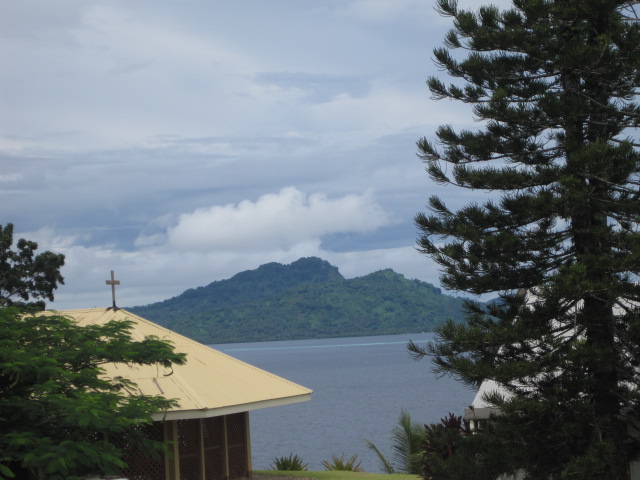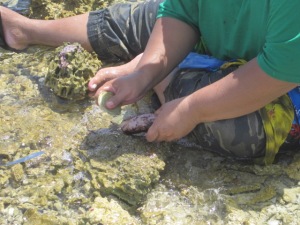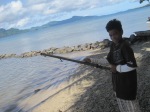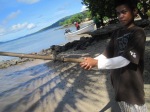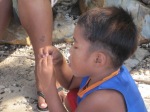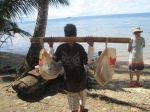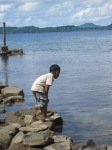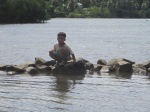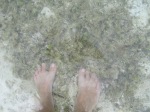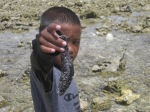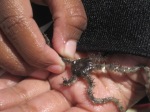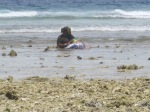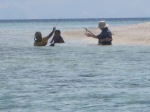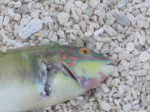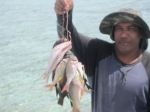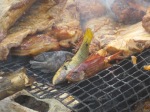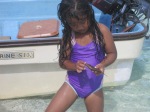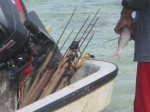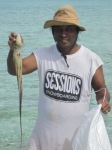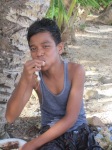Woo-hoo! The internet is back. But did I miss it?
As a child when did I first hear about trout fishing in America?–Richard Brautigan
 Saturday marked the annual Xavier staff picnic. Custodians, mechanics, cooks, office workers, teachers, we all piled into motor boats and headed out to a tiny reef island for some barbecue. Cut to: A quick geography lesson–the islands of Chuuk are defined by their relationship to an enormous coral reef –140 miles in perimeter and 820 square miles in area–which surrounds the state. Islands are either inner islands, reef islands, or outer islands. The reef islands actually sit on the reef, and depending on the tides, you can walk along the reef among them During a low tide several islands may appear as one. The reef itself is interesting. It forms the Chuuk (Truk lagoon). The Pacific Ocean waves break on the reef with violent force, while inside the lagoon there are no swells at all. Although the reef is roughly five miles out from the coast of Weno, if you take the time to listen, you can hear the surf constantly. In the early morning, when all is still, it almost sounds like traffic–almost. From time to time an enormous swell will crash, and even at this distance, it sounds like a freight train is running along the horizon. Father Rich, the director of all things Xavier sits on the porch in the morning gathering his thoughts. A deeply religios man, I am convinced he hears those waves as the voice of God. Although I am not nearly as deeply religious as he, I have enjoyed the times we have sat there in silence, listening for whatever voices we can hear in the surf.
Saturday marked the annual Xavier staff picnic. Custodians, mechanics, cooks, office workers, teachers, we all piled into motor boats and headed out to a tiny reef island for some barbecue. Cut to: A quick geography lesson–the islands of Chuuk are defined by their relationship to an enormous coral reef –140 miles in perimeter and 820 square miles in area–which surrounds the state. Islands are either inner islands, reef islands, or outer islands. The reef islands actually sit on the reef, and depending on the tides, you can walk along the reef among them During a low tide several islands may appear as one. The reef itself is interesting. It forms the Chuuk (Truk lagoon). The Pacific Ocean waves break on the reef with violent force, while inside the lagoon there are no swells at all. Although the reef is roughly five miles out from the coast of Weno, if you take the time to listen, you can hear the surf constantly. In the early morning, when all is still, it almost sounds like traffic–almost. From time to time an enormous swell will crash, and even at this distance, it sounds like a freight train is running along the horizon. Father Rich, the director of all things Xavier sits on the porch in the morning gathering his thoughts. A deeply religios man, I am convinced he hears those waves as the voice of God. Although I am not nearly as deeply religious as he, I have enjoyed the times we have sat there in silence, listening for whatever voices we can hear in the surf.
Meanwhile…
So on Saturday morning we schlepped our food, coolers, snorkeling gear, and whatever else we thought we might need to the Xaver dock. Around 8:30 in the morning, the word went out to head on down to the dock, which is about a quarter mile down the hill, along a jungle path mined with rotten breadfruit. They’re very slippery and will take you down and leave you flailing in a muddy putrid mess if not careful. The path then meets up with a rutted out road which leads to the water’s edge–but the two are hardly distinguishable. The Xavier dock is a dock in the name only. Much like the road on the island, it’s little more than remnants of what might have been a useful construct. Now it just sort of makes due. Some concrete blocks that once formed some coherent shape, some rebar sticking up, and the rusted remains of what was once a steel frame constitute the entire structure.
Walking to the Xavier dock is always a trip. As we amble down, we pick up children along the way. I don’t know if they are just curious or what, but they seem to come out of the woods every time I go down and trail along behind me. It’s not uncommon for me to walk down to the water’s edge–starting alone and arriving with five toddlers in tow.
Island time is a rich tradition; I’d even go so far as to call it a sacred institution, observed by all on Weno religiously. The Americans, hearing that we should head down to the dock, thought that that meant now. We gathered up our belongings and walked down to the dock. It took roughly fifteen minutes to get there. We then waited an hour and a half for the others to arrive plus an extra half hour for the boats to show up. Funny thing about those sacred religious traditions…sometimes great truths are revealed within them. For, in the two hours that I waited for co-picnicers and the flotilla to arrive, I skipped dozens of stones, gathered innumerable shells, coaxed hermit crabs out of their shells (You can do this by putting the close to your mouth and bubble moises.), learned how to ask someone’s name in Chuukese (Ephi-tom), and figured out how a spear fishing gun worked with the local Sapuk children–time much better spent than it might have been had I dwelled instead on how late everyone was, and how the pig tied to the tree smelled, and how many flies there were, and… you fill in the blank with any of the myriad minor annoyances that populate a tropical paradise.
religiously. The Americans, hearing that we should head down to the dock, thought that that meant now. We gathered up our belongings and walked down to the dock. It took roughly fifteen minutes to get there. We then waited an hour and a half for the others to arrive plus an extra half hour for the boats to show up. Funny thing about those sacred religious traditions…sometimes great truths are revealed within them. For, in the two hours that I waited for co-picnicers and the flotilla to arrive, I skipped dozens of stones, gathered innumerable shells, coaxed hermit crabs out of their shells (You can do this by putting the close to your mouth and bubble moises.), learned how to ask someone’s name in Chuukese (Ephi-tom), and figured out how a spear fishing gun worked with the local Sapuk children–time much better spent than it might have been had I dwelled instead on how late everyone was, and how the pig tied to the tree smelled, and how many flies there were, and… you fill in the blank with any of the myriad minor annoyances that populate a tropical paradise.
When the boats arrived, we started loading them up. You know that scene in the movie Jaws when all the fishermen are overloading the boats to go after the shark and collect the reward for bringing it in and Richard Dreyfus makes the comment that none of these yahoos are going to make it out of the harbor alive? Yeah, it was kind of like that. “Climb on into the boat, Chris. Just don’t step in that hole.” We’re going five miles out into the ocean in this craft?!?!? Far from yar, this boat was barely seaworthy. The gunwales of the boat were even with the water’s surface, and I swear that as we were motoring across the lagoon, we were actually lower than the surface, and it was some freak in the laws of physics that kept the water out as we moved.
I’ve rambled on for quite a long time now, and there’s much more I could add…how the boat with my friend Nancy and me went to the wrong island, and we waited for the flotilla to arrive with the food, but it never came…how a small boy spoke Chuukese to me all day, and I never said anything, only smiled and made funny faces back, because I didn’t think he spoke English until he said, “Is your name Bob or Chris?”…how while wading along the top of the reef an eel shot out of its hole and started attacking me nipping at my shins. But that’s not spearfishing in Micronesia………………….
When all the boats that went to the wrong islands were located and brought to the right island, that’s when spearfishing in Micronesia kicked in. Coolers with drinks and chicken and ribs were dropped off on the shore of a picturesque tiny island. It looked like the stereotypical New Yorker cartoon with the guy sleeping under the coconut tree. Most of the men then hopped back in their boats with homemade spear guns and set off for deeper waters. Meanwhile women and children waded out in the shallows of the reef. While the men were out, the women gathered the sea cucumbers, scraped them down to remove the fuzzy exterior. The tool for this was, more often than not, the lid from a tin can. Then they would take rock or piece of coral and bash the cucumber until it was left flat and tenderized. This was all the preparation needed before this hors d’oeuvre was served.
In the meantime, the men were out spearfishing with crudely fashioned spear guns. The barrel was a long thin hand-carved piece of wood. A strap of surgical tubing was attached at one end and pulled back and hooked with a paper clip to a makeshift trigger. A sharpened piece of metal was then attached in such a way that when the trigger was pulled, the surgical tube acted like a slingshot, launching the spear.
The men went out for several hours. They would snorkel with their spears or just wade where it was shallow enough. With incredible accuracy, they would launch their spears and strike a fish, piercing it. Next they would take a wire and use it as a stringer, poking it through the hole in the fish. On a side note, there has been a problem with Chuukese fishermen and sharks. It is common practice to attach these stringers to your waste as you wade and snorkel around hunting for more fish. Sharks smell the blood or sense the dying fish’s flapping around and are attracted to them. It doesn’t take Nobel-aureate to figure out what happens next.
After awhile, the boats came back in, loaded with stringers of every color of fish and men with teeth red from beetle nut. The women, children, and men alike took part in cleaning the fish. Some men pulled their boats on shore, and, taking handfulls of coarse coral sand, rubbed down their boats. As each fish was cleaned it was taken to the fire and barbecued on the spot. This–when paired with breadfruit and banana marinated in coconut, pineapple and tapioca–makes a great lunch.
There is no way to properly describe this day in words–the laughter, the beauty, the food, any of it–so please take a look at the pictures–it’s all I got:
- Cleaning sea cucumber
- The Hermit Crab Whisperer
- Cleaning sea cucumber
- Junior and his spear gun.
- Octopus!!! Check out the t-shirt.
- Sanding the boat
